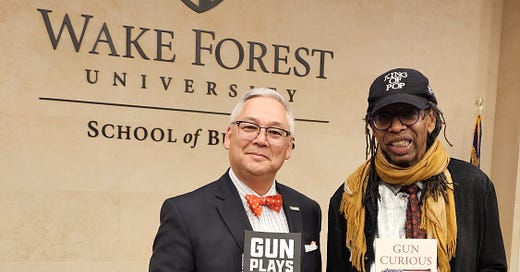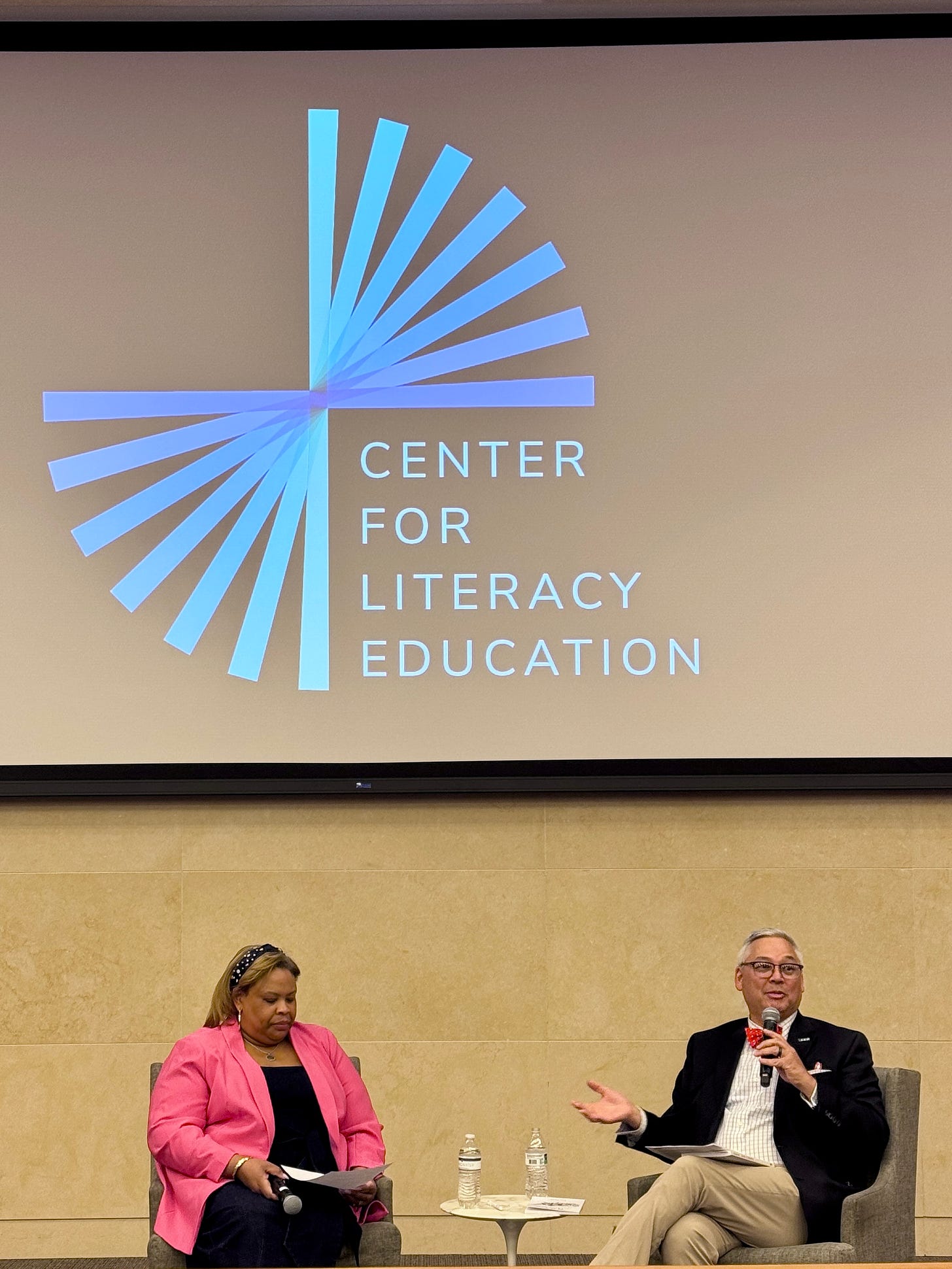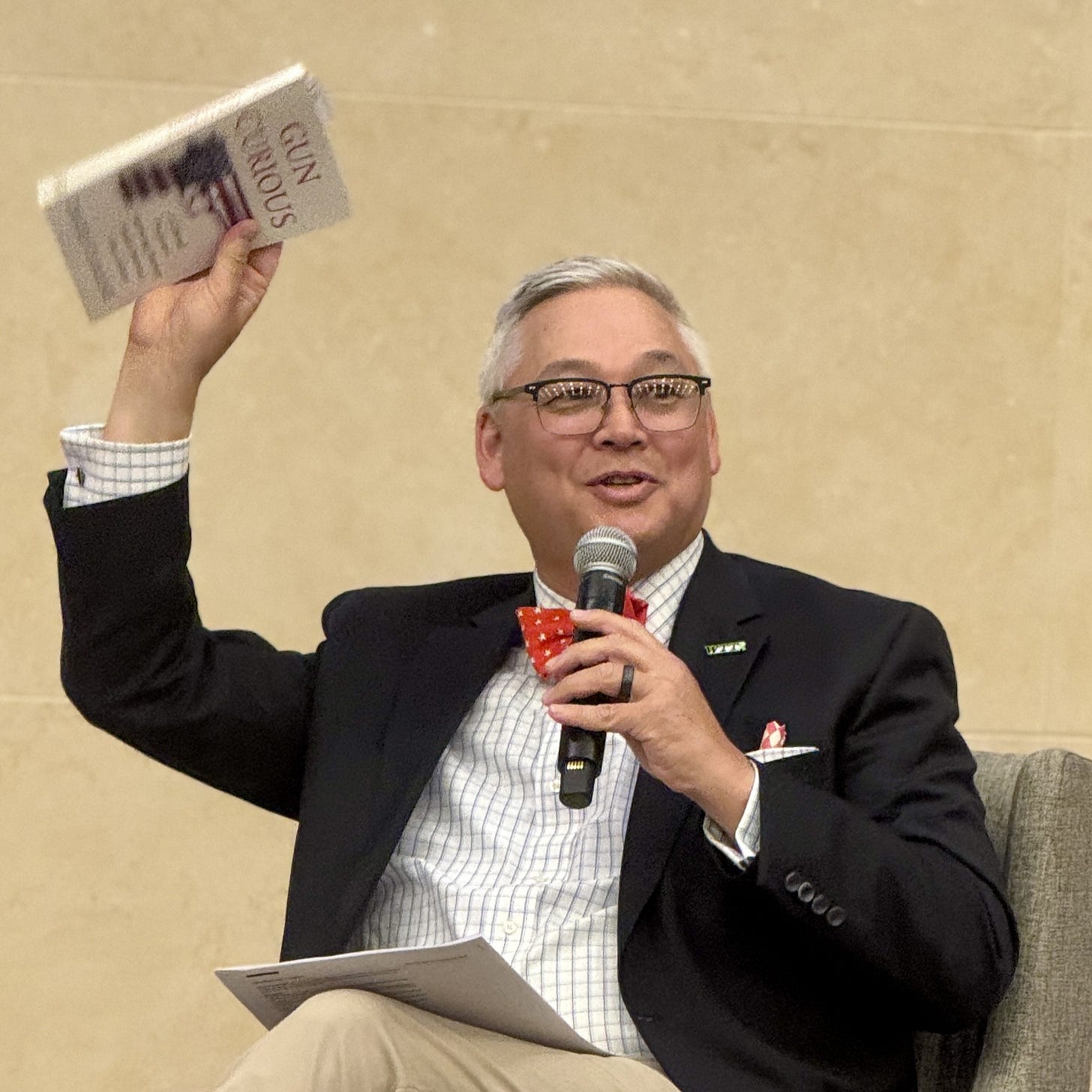Reflections on "A Gun is Not Fun" Conference
I hope I did some teaching and I definitely did some learning
Last week, I was fortunate to take part in a visiting scholar speaker series and community networking conference organized by Wake Forest University’s Center for Literacy Education. I am grateful to Center director Alan Brown for including me in “A Gun is Not Fun: Strategies to Keep Children Safe from Gun Violence.”
The conference centered on the work of seven-time Emmy-winning “Sesame Street” writer William Electric Black, in particular a children’s book he has written called A Gun is Not Fun.
I preregistered some of my thoughts on this topic in an earlier Substack post.
Three panels preceded Black’s keynote address. The first panel focused on gun injury prevention strategies and the second panel focused on public safety. Mine was the third panel and was supposed to include a fellow social scientist, but she had to withdraw at the last minute. Consequently, the entire panel became a conversation between me and the moderator, Kimberly S. Jones, the 2023-2024 NC Teacher of the Year.
During my 40 minutes, I did some teaching and, more importantly, I did some learning.
On the teaching side, I spoke about the journey inside gun culture that my book, Gun Curious, describes, especially my central premise that guns are normal and normal people use guns.
I discussed a common misperception that gun owners don’t care about negative outcomes with firearms — e.g., “You value your guns more than kids.” I pointed out that Kelly Farmer from the NRA’s Eddie Eagle program had driven down from Virginia for the event and that Tim Kelly from Apache Firearms Solutions was also in attendance. Tim has recently written a book called Your World Is Not A Gun-Free Zone: A Guide to Raising Curious Kids of All Ages Responsibly and Safely in Armed Homes, Families, and Communities. I also took the opportunity to shout out the great work being done by Michael Sodini and Walk the Talk America to bridge the gap between mental health and responsible firearm ownership.
From there, I covered some facts about gun violence and gun safety. I didn’t win any fans by questioning the commonly invoked idea that “guns are now the leading cause of death for children in America” (some data and interpretation here and here). I also highlighted the overwhelming proportion of gun owners who store their guns safely (85% in households with children, according to the 2021 National Firearms Survey).
Continuing the discussion of gun safety, I highlighted two view of gun safety (about which I have posted on Substack already): safety with guns and safety from guns. I noted that the safety from guns approach sees guns as fundamentally harmful and that the only way to be truly safe from them is to stay away. This, I said, is akin to abstinence-only sex education.
It was in this section of the panel that I shifted from teaching to learning.
One of the things I enjoy about presenting my ideas in real time before a live audience is that it allows me to get some immediate feedback on whether I am communicating effectively. As my friend and communication professional Robin always tells me, “Communication takes place in the mind of the listener.”
I often try to use analogies to help people who do not know about guns understand them better. Sometimes these analogies work, and sometimes they don’t. It’s only by trying the analogies that I can know whether they work or not.
For example, when I spoke to a course on “The Wicked Problem of Gun Violence” at the University of Virginia’s Batten School of Public Policy last fall, I used an analogy I thought would work well to convey how safe guns and gun owners are overall. “A challenge we face is that gun owners safely using their guns is not newsworthy,” I said. My analogy: “‘Pilot Crashes Plane’ is newsworthy. ‘Pilot Lands Plane Safely’ is not. Gun owners are successfully landing the firearm safety plane millions of times every year.”
In response to this analogy, one student highlighted how strictly regulated air travel is. The pilots who are entrusted to land planes safely are regulated far more strictly than gun owners are. So, he concluded, I was comparing apples to oranges. I thought this was a fair point and made me rethink that particular analogy.
Back at the “A Gun is Not Fun” conference, I pressed the analogy between the safety from guns approach and other abstinence-only approaches to safety:
Sex is not fun.
Driving cars is not fun.
Swimming is not fun.
Rock climbing, whitewater rafting, skiing, kiteboarding, backpacking, skydiving, scuba diving, bungee jumping — the list goes on and on.
It doesn’t make sense to tell children that these things are not fun, when for many people they absolutely are fun.
Because the basic less of A Gun is Not Fun is the same as the NRA’s Eddie Eagle — “If you see a gun run. Tell a grown up, call 9-1-1” — I suggested that the real story William Electric Black was telling in his book is: A Gun is Not a Toy.
From the back of the auditorium, Black objected that his book A Gun is Not Fun was written for 3-, 4-, and 5-year-olds. I responded that even 3-, 4-, and 5-year-olds can have fun shooting guns.
Moderator Kimberly Jones offered that a 5-year-old might have fun taking edibles but we wouldn’t generally allow them to do that. This made me realize that my analogies might work for adolescents (12-18 year olds), but not for younger children.
In my desire to make the point, I had taken the analogy too far. I would have been on much firmer ground had I stuck to my original point, preregistered here on Substack:
Like guns, playing in water is fun. Like guns, playing in water is dangerous. That’s why we teach children to swim, even at ages when we would never let them swim unsupervised. We want them to be safe in water, not safe from water.
So, when I say that 3-, 4-, and 5-year-olds can have fun shooting guns, I mean under direct adult supervision. Just like I would never send my kids to an unsupervised pool when they were that age.
My dear wife Sandy, who was in attendance at the event, got very stressed during this portion of the panel. She thought I was having a conflict with the guest of honor. My friend Robin thought my messaging had lost the audience.
I’m sure I did lose some of the audience by taking the analogy too far. Lesson learned. But if you don’t learn something from your experiences, what’s the point?
I definitely did not experience this part of the panel as stressful, though. To the contrary, I thought it was the best part because William Electric Black and I are two people who do not want any children to suffer harm from firearms and we had a civil conversation about our differences in achieving that common goal.
I don’t think he held my suggestion that he re-title his book against me, either. We enjoyed a nice chat after his keynote and shared a photo with each other’s books.







Sounds good. I think the analogy to bike education is somewhat relevant. When I was president of the Hawaii Bicycling League, the statewide bicycle organization in Hawaii, I got familiar with HBL’s long established 4th Grade BikeEd program. We wait till 4th grade because we learned, or perhaps taught ourselves, that you needed to be 9-10 years old before it made any sense to teach kids how to ride safely on public roads. Even quiet public roads.
I help run a Jr Rifle program at a local club. We often have kid as young as 8 because younger they usually can't really hold the rifle even though we small Marlin model 15s. But we have had 7yo shoot small .22 caliber pistols - single shot. And the look of joy most of the time is amazing. They also listened and paid attention to gun safety, 3-4 I think may be too young as they are too small for even the smallest of handguns.